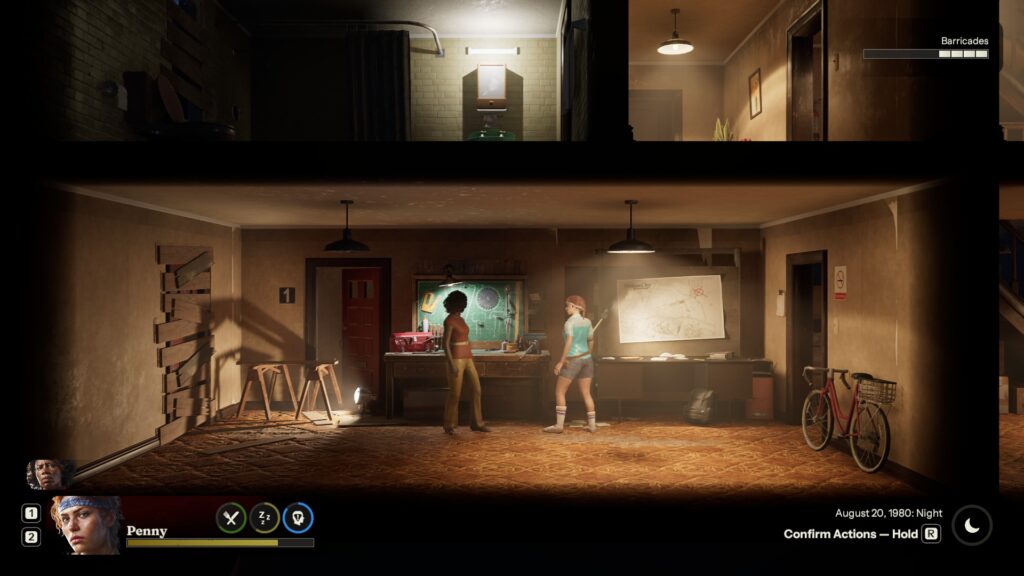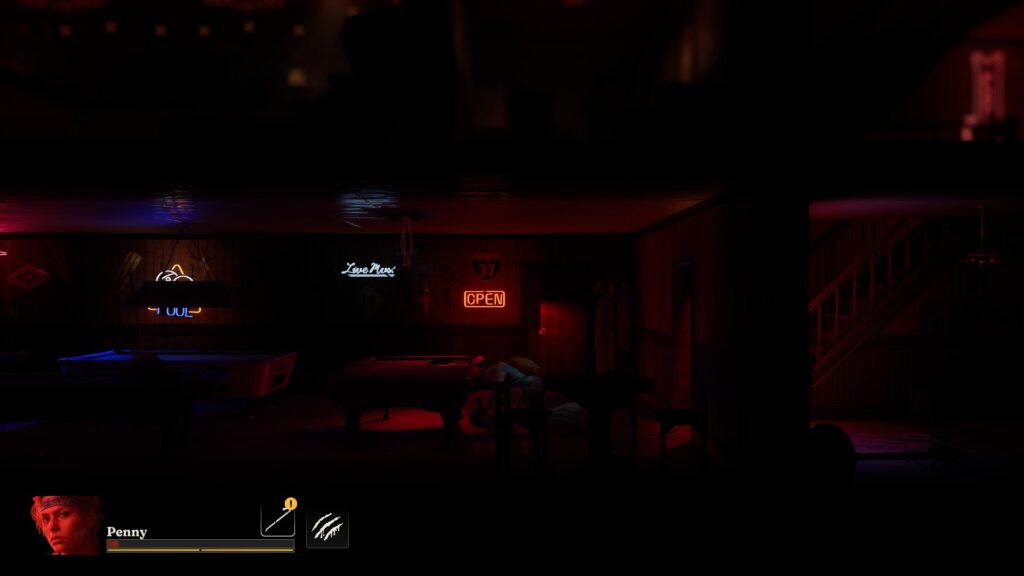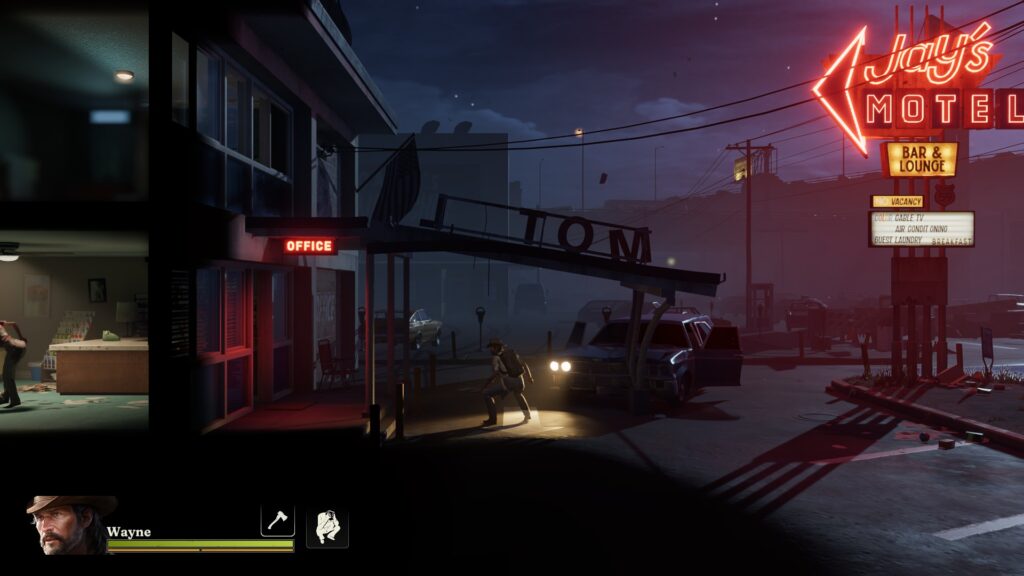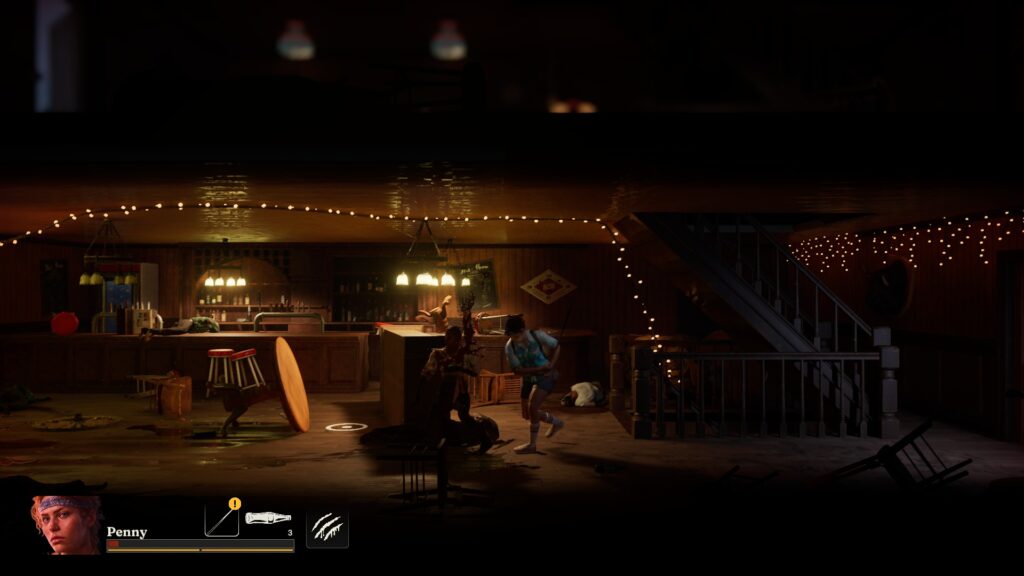It’s the summer of 1980. The undead have taken over Texas. Nobody is coming to help you.
Into the Dead: Our Darkest Days (ITD) puts you in the centre of a zombie apocalypse where every decision could be your last. Set in the summer of 1980, Texas has been overrun by the undead. Combining the gameplay of This War of Mine with the setting of State of Decay, ITD delivers a mix of action, stealth, and resource management that’s as difficult as it is rewarding.
At the heart of ITD is a day-and-night cycle that forces you to juggle risk and reward. You assign survivors tasks such as cooking, crafting, repairing, or sleeping. These survivors are selected from five pairs, with two unique, complementary strengths and a weakness.
Their health, hunger, and sanity need to be balanced carefully against the ever-present need for supplies. Scavenging for supplies is a necessity – whether it’s food, medicine, or weapons, every run is a risky venture where each location could be your saving grace or your downfall.

Scavenging leads to discovering new shelters, each with distinct layouts and perks, along with a scavenging location. Moving from shelter to shelter is necessary for survival, as eventually, the horde will overrun your location. Constantly moving, progressing, is a must, as death is permanent and mistakes are costly – there are consequences for your actions.
This loop delivers a genuinely satisfying experience which, as you invest more time into the game, rewards you with knowledge, and as they say, knowledge is power. With each run, you learn to adapt to the harsh reality that is ITD, understanding when to play it safe or when to take risks. It’s a constant battle between your knowledge, experience, and intuition – sometimes, it’s best to follow your gut feeling.

Graphically, Into The Dead: Our Darkest Day’s colour palette paints a dark, grim picture, serving to create a tense atmosphere and capturing the bleak reality of a state clinging to survival. Locations feel desolate, forgotten, and in disarray due to the panic that came with the horde. There are only corpses on the ground and zombies hiding behind closed doors and in the shadows – be sure not to shine your torch in their direction.
The ambient sounds of floors creaking as you walk through locations does an impactful job at highlighting how forgotten these places are. The silence serves as a reminder that stealth is the best approach, and using the cover of shadows is key to survival. Avoiding direct confrontation was always the most optimal approach, and peeking through doors became second nature to me. However, it wasn’t always possible. In other games, forced engagements feel like a chore and break immersion, here however, they add to the atmosphere and the tension.

This audio design works in conjunction with the art direction to further build upon the tense atmosphere. The growls and moans of zombies fill the air with a sense of dread and fear, but no more so than when you are spotted. The blood-curdling scream they let out was horrific, sending chills down my spine – my adrenaline was high, as too was my fear.
Where ITD falters, however, is in its silent exploration. Whether this is good or bad depends entirely on you, for me however, it’s a negative. While I understand the lack of audio serves to enforce the point that the world is empty and forgotten, to me, it’s a lost element of suspense – light ambient music would have done wonders to reinforce the tense atmosphere.
The music in the main menu and at your base sets a somber tone, but the absence of ambient tracks while exploring leaves the atmosphere feeling underwhelming. I’d have loved simple tracks, enhancing the feeling of dread, especially when all the other elements work brilliantly in creating a grim world. Being an Early Access title, however, I can forgive this.

Controls are simple and intuitive, but not without issues. Combat and movement feel sluggish, both with mouse and keyboard and controller. Further, not all key mapping icons appeared correctly, for example, the icon to equip weapons was (Y) instead of (A).
Travelling between background and foreground doesn’t feel fluid, nor does climbing or vaulting, with a moments delay before each. Speaking of backgrounds, I must highlight how flat and lifeless external environments look, not just thematically but also visually. This is a shame, as great care has been given to internal environments.
Internally, you can see the history of the locations and feel what events took place there. Outside, however, lighting and shadows aren’t realistic, and seeing assets, such as paper blowing about, spawned in from fixed locations detracts from the experience. This is a testament to ITD as a whole – where it does well, it does so exceptionally, where it falls short, however, it detracts greatly. Again, being in early access, I can overlook this. The foundation is more than solid, and my issues can be improved upon.

At its core, ITD is a survival game that doesn’t hold your hand. It teaches you the brutality of living in a world where a single error could cost you your life. If you’re the kind of player who enjoys overcoming difficult odds and learning through failure, there’s plenty of depth to sink your teeth into.
As there’s no meta progression, if you’re not interested in investing your time to learn and master the systems, you might not feel compelled to return. Simply put, the longevity of ITD is determined by the player.
If you’re looking to challenge yourself, the permanent death will have you hooked. Casual players may be deterred, however. Being an Early Access title with a detailed road map, the future looks promising, with the developers promising a flourishing game. Despite the issues I listed, in its current state, I still highly recommend ITD.
INTO THE DEAD: OUR DARKEST DAYS (EARLY ACCESS) REVIEW
GREAT
7.5
Into the Dead: Our Darkest Days combines the gameplay of This War of Mine with the setting of State of Decay, delivering a mix of action, stealth, and resource management that’s as difficult as it is rewarding.
PROS
- New survivors can be found while scavenging, but not all encounters will end peacefully
- Art direction oozes 80s charm, with cassette icons, retro fonts, and evocative location design
- Built around a try, fail, retry system of learning through experience, the more effort you invest, the easier it becomes, leading to natural progression
CONS
- Combat and movement feel sluggish
- Only a single save slot, limiting experimentation with different survivors or choices
- Only one difficulty, with no difficulty modifiers, making it less accessible to casual players
Reviewed on PC in Early Access. A review code was provided by the Publisher for purposes of this review.
